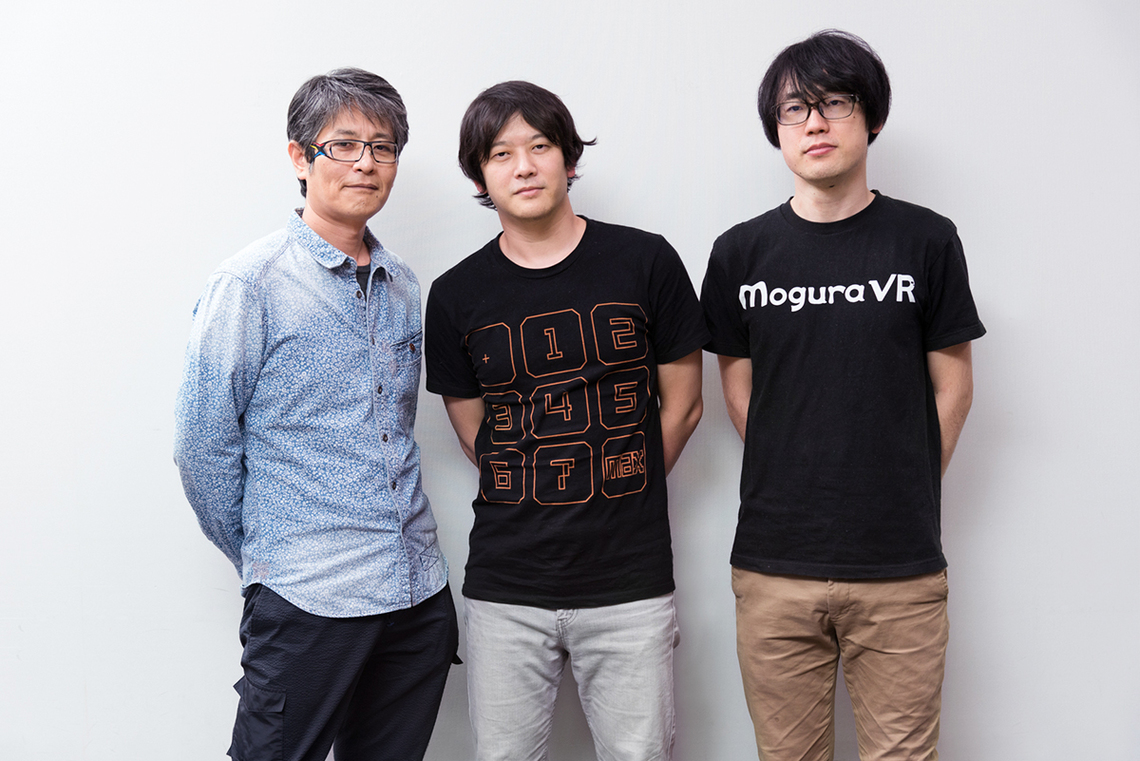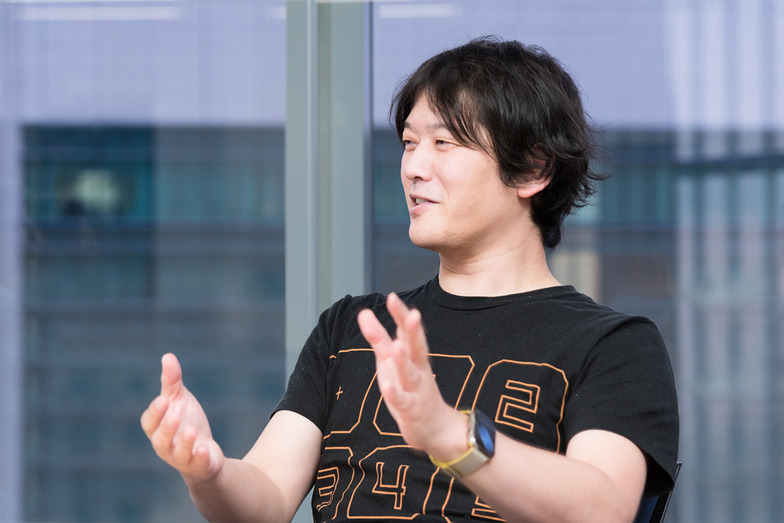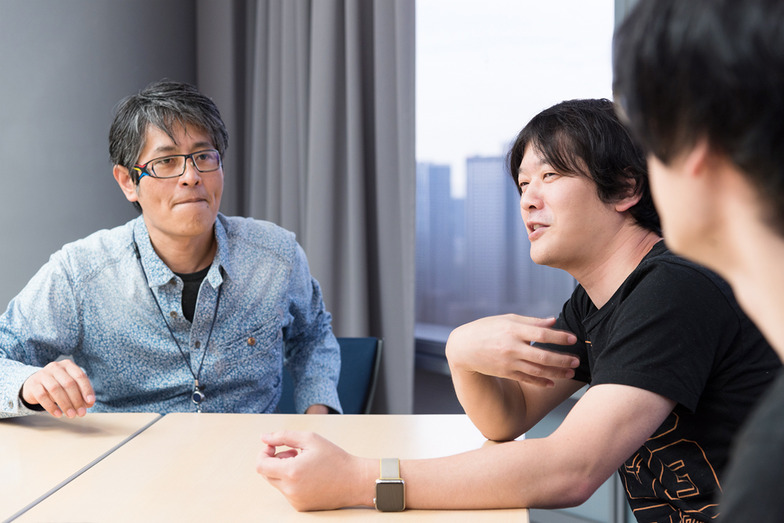Three individuals who could be called Japan's leading VR evangelists gathered.
Because they know VR's past, they can speak to its future.
Their virtual reality might just be the next reality.

From left: Hikaru Adachi, Yoshihito Kondo, Shun Kubota
The Initial Impact
Kondo: I think it was about three years ago when I first met Mr. Adachi? We had him try the Oculus Rift DK1, the first-generation head-mounted display (HMD).
Adachi: Shaking hands with Hatsune Miku was absolutely shocking.
Kondo: Even though it was our first meeting, you were so excited, Adachi-san, saying, "Man, my time has finally come," and you were actually tearing up watching it (laughs).
Adachi: I was crying "Thank you" (laughs). I'd seen various VR experiences, but that one exceeded my expectations. It was the moment I became convinced VR would be the next media to revitalize the market, creating new business models. I thought, "This is where I belong!"
Kondo: I'm glad to hear you say that. With VR, everyone is first visually amazed, but then what they do next is try putting their hand in. But that hand doesn't appear in the VR space. That's when they realize, "Oh, it was just an image," and the immersion breaks. But when Miku takes your hand there, the boundary with reality disappears.
Adachi: The next shock came when I encountered Oculus's "Toybox" at the 2015 Tokyo Game Show. You could move your hands freely in VR and play together with someone else. I thought, "This is how VR will cross the chasm and burst into the mainstream."
Now, investment in VR is accelerating worldwide. Just a little while ago, the visuals were really lackluster, but the quality has skyrocketed all at once.
Kondo: Studios like Oculus' Felix & Paul Studios are creating incredibly high-quality visuals. But making great content still requires significant investment.
Adachi: Like in film, forming production committees with sponsoring companies to pool budgets and create quality content is one approach. I think current media players like broadcasters and publishers are also reaching a point where they need to move to the next phase. Then there's the question of how to integrate advertising.
Kondo: Just like when TV emerged alongside radio, it's unwise to apply the same rules or advertising methods to both. Advertising will become increasingly personalized going forward.
Kubota: I imagine VR home screens will become customizable too. Furthermore, if you see something in the virtual world and think, "Hey, that chair looks nice," systems will emerge where you can actually buy it in the real world.
Adachi: The ideal scenario is for ads themselves to become high-quality, enjoyable content. I expect we'll see more of that. Also, I think there are unique ways to present ads specific to VR spaces. Like putting ads on virtual billboards, or having characters use or wear products. We want to create more and more examples of this going forward.
"Raw Oysters" and "VR Injury Accidents"
Kondo: But right now is the time to keep sowing seeds. I don't think we should focus too much on monetization just yet. There are already plenty of people who feel they couldn't live without the internet. VR will probably become that kind of indispensable infrastructure too – once you experience it, there's no going back.
Adachi: But it all starts with people actually experiencing it. That's why we're focusing on location-based VR like VR THEATER, where many people can easily try it out. We want places where people can touch and try it right in their neighborhood when they go out. Hopefully, after visiting a few times, they'll discover content they love.
Kondo: My approach is a bit different. I want to blow people's minds with the absolute best experience right from the start. Then, they'll bring 100 people with them next time.
Adachi: What you see first is really important. If you start with something poorly made, you might get VR sickness.
Kondo: I call it "raw oysters." If someone tells you it's delicious and you try it, only to get food poisoning, you'll never touch them again. VR is the same. If you get sick from your first experience, you'll develop an allergy to it.
But if you try to make it less prone to motion sickness, you risk sacrificing the creator's vision. It becomes a tug-of-war with directors who want to move the camera exactly as they envision.
I think we should just rate the content. Like a curry shop: mild, medium, spicy, 20-spice (laughs). Newcomers start with mild. If they think, "No motion sickness, I can handle this," they can challenge themselves with medium or spicy.
Adachi: That's true. But quantification is tricky. We have an affiliate company called Dentsu ScienceJam Inc. that's developing technology to measure brainwaves and quantify sensory responses. Incorporating that kind of tech might be one approach. It's not just about motion sickness; since VR involves a one-on-one interaction with the content, it can have a profound impact on both mind and body.
Kondo: I'm concerned that VR is increasingly being used as a gimmick in events and ad campaigns, with the effects getting more and more extreme. Things like adventure or horror experiences that shock people excessively. We need to establish some kind of self-regulation or guidelines quickly, or accidents could happen.
Adachi: I absolutely hate horror. I always prepare to be able to take off the HMD at any moment, but I forget when I get immersed. I've even fallen out of my chair screaming "Gyaa!" in front of a client (laughs).
Kondo: Exactly. You should just close your eyes, but you can't. It's natural—humans instinctively open their eyes when danger approaches. VR is a device that amplifies that instinct. Unlike watching TV in your living room, you're suddenly thrown into a completely different world with no escape. It can cause panic.
Horror comes in many forms—psychological stuff like "Sadako" and jump-scare haunted house-style. With the latter, you could totally fall over in a panic, hit your head, and end up in an ambulance. The moment "VR causes injury" hits the news, regulations will inevitably tighten.
Kubota: Experiences designed for sharing with others, like Bandai Namco's VR ZONE, can help mitigate panic, right? We might be entering a phase where such ideas and insights are accumulating.
Adachi: Game engines that used to cost tens of millions of yen are now available for free, accessible even to students. People are easily creating and posting content on platforms like YouTube. Regulation might be difficult. But user ratings could foster a self-cleansing effect.
Next up: Social VR
Kondo: The current challenge for VR content is how to encourage repeat engagement. For games, there's no absolute necessity that it has to be VR. For experiential content, even if it's amazing, once is often enough.
Adachi: While not avatars, I see huge potential in chat and community interaction. Toybox was genuinely fun. I think VR could simply provide a social space. For example, people playing chess together could revive interest in board games. I believe the next frontier is social VR.
Kondo: True, VR lets people worldwide enjoy themselves and communicate from home. But on the flip side, problems are emerging too.
Adachi: Like social harassment. Women logging into their personal space only to find creepy people there.
Kubota: We started hearing about that around this year, right? And bullying too. Things like relentlessly punching someone – actions impossible in reality become unrestricted in VR space. It could potentially cause more psychological damage than in real life.
Adachi: That's similar to the problems the internet faces now. Maybe we need a system that verifies people's identities.
Kondo: But even if there are problems, asking "Do you use the internet?" is already rude—it's just a given. Similarly, as VR becomes more widespread, it'll eventually feel as natural as air. By then, the term "VR" itself might disappear. You'll see grandmas in the countryside cheering for their grandkids' sports day from afar.
Adachi: When you talk like that, people get really interested. For someone in their 20s, Hatsune Miku resonates. But for a 60-year-old whose kids are already in college and living away from home, if you say, "You can go back to those days of sitting around the table eating dinner with your kids," they perk right up.
Kondo: Just one tailored experience can turn someone who previously disliked VR into an evangelist overnight. Even when they're out, they'll think, "Ah, I just want to hurry home and put on my HMD!" Maybe we should start a "Japan VR Sommelier Association" to recommend the perfect experience for each person (laughs).
The essence of VR is "presence"
Kondo: The reason I decided to dedicate my life to VR is because I felt "presence" within it. Nowadays, 360-degree videos are proliferating on social media. But if someone tells me they've "done VR" based on that, I want to say, like Yamaoka from the manga "Oishinbo," "Let me show you real VR. Come back tomorrow" (laughs).
I don't believe the ability to look around 360 degrees is the essence of VR. Truly high-end VR has incredible presence. It's hard to put into words, but it's that feeling of "being there" – as if you're actually physically present, or as if you've actually gone there. This "presence" is the very essence and raison d'être of VR. When Mr. Adachi shook hands with Hatsune Miku and their eyes met, the boundary with reality vanished because he felt that presence.
Adachi: For example, the pathways leading up to attractions at Disneyland or Universal Studios Japan are like that too.
Kondo: Exactly. That's the introductory magic that heightens presence. When you see Mickey Mouse at Disneyland, you don't think there's a person inside. You go in expecting to be fooled. VR has that same feeling of being under a spell, of your brain being tricked.
Kubota: You mentioned it's "like glass."
Kondo: Exactly. Because it's magic, it can shatter in an instant. Making people want to stay there forever is crucial. The moment you think, "Is this CG?", the glass shatters. It requires immense care.
Above all, I want people to feel presence. I want them to create things with presence. First, I want them to experience a dish packed full of presence and understand VR's potential.









